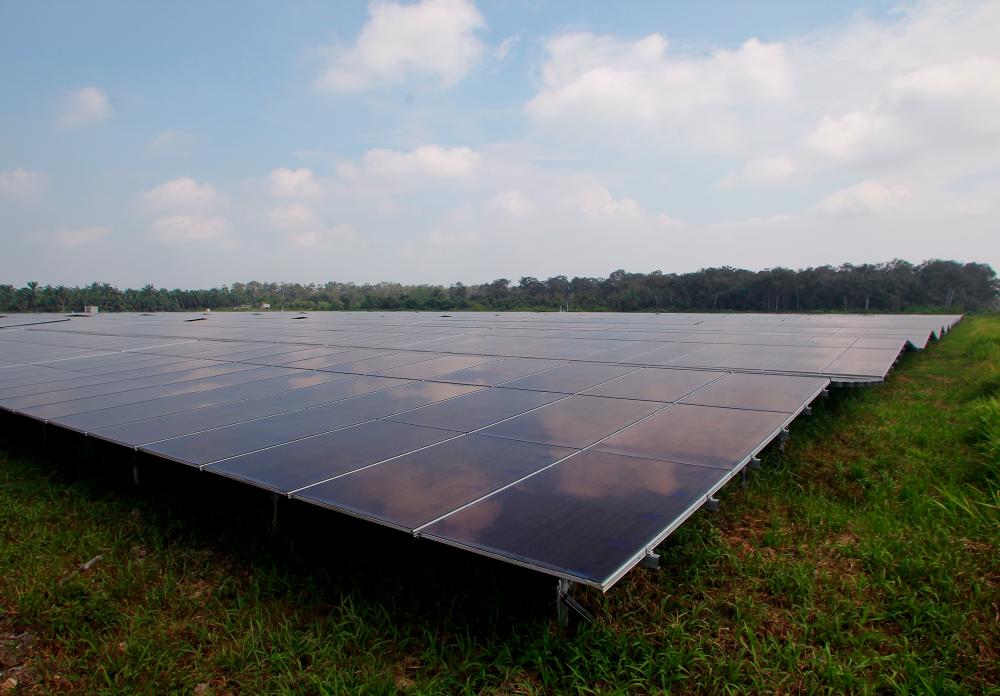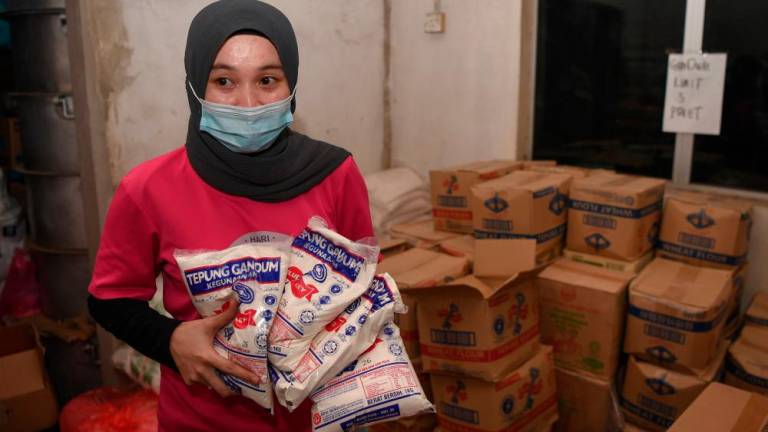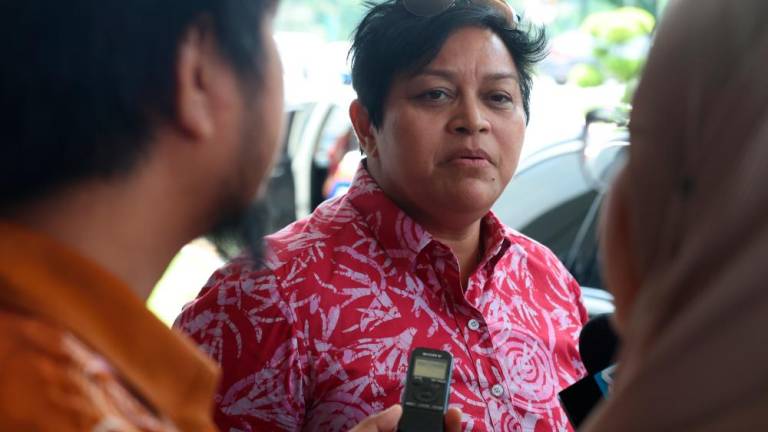KUALA LUMPUR: As Malaysia turns to the sun big-time to power up the nation, addressing the issue of an impending solar waste glut becomes ever more important.
The country is already one of the top exporters of solar photovoltaic (PV) panels. If it plays its cards right by venturing into solar panel recycling, it can turn a potential problem into an opportunity to pursue new economic avenues.
However, at the moment, Malaysia is still working out a framework on how to deal with solar waste. It is looking at solar energy making up 58 percent of the energy mix by 2050, and plans to do so by setting a target of 59 GW solar PV capacity by then.
Bernama did a rough calculation of how many solar PV panels this would involve, and it appears to be around 164 million.
The real figure could be much larger. The nation started including solar energy into the national energy mix in the early 2000s. As such, most of the solar PV panels installed are likely to have retired. What’s more, while solar PV panels typically last 25-30 years, they age out faster in hotter climates like Malaysia’s.
Without a proper framework on managing solar waste, where will all these dead panels end up?
Most likely in landfills, says Ute Collier, the acting director of the Knowledge, Policy and Finance Centre at the International Renewable Energy Agency (IRENA). IRENA is an intergovernmental agency for energy transformation.
“Circular economy principles for reusing or recycling end-of-life solar PV are not being followed. Some major barriers for this include the unclear economic profit for recyclers when considering costs needed for collection and transportation, lack of information on PV components and available PV recycling technologies, and undeveloped PV recycling technologies,” she tells Bernama.
ERS Energy, one of Malaysia’s largest solar energy solutions providers, confirms this dilemma. The company has been storing decommissioned PV panels in its own warehouse over the years to prevent them from ending up in landfills. However, they eventually ran out of space and were forced to rent third-party warehouses to store their dead panels.
“The lack of local facilities together with costly international logistics have proved to be huge challenges to responsible disposal of the solar panels,” says Angeline Teoh, its associate director of Communications & Sustainability. “Recycling solar panels poses challenges due to the complex composition of materials. Challenges include separating and recovering valuable components, the need for specialised recycling facilities and adherence to environmental regulations.”
THE POTENTIAL OF A RECYCLING INDUSTRY
Despite that, solar PV panel recycling remains one of the most promising solutions to the solar waste problem. Six out of 10 of the world’s largest solar PV companies operate out of Malaysia. As Malaysia is one of the top exporters of solar PV panels, it has the golden opportunity to develop and cultivate a thriving recycling industry for it.
Due to its position in the PV market, IRENA believes that Malaysia will benefit from adopting a circular economy for solar PV panels.
“As one of the countries engaged in solar PV manufacturing, Malaysia is well-positioned to capitalise on opportunities by embracing the ‘reduce’ and ‘reuse’ principles within the existing supply chain,” says Collier.
A report by IRENA in 2016 places emphasis on recycling PV panels at their end-of-life. Recycled panels are capable of providing a large supply of raw materials and other valuable elements which can be funnelled back into the economy through the production of new PV panels or sold back into global commodity markets. This, according to IRENA, will help in strengthening the security of our supply of future raw materials.
Malaysia stands to have an advantage over other countries in the region if it chooses to get a head start on solar PV recycling.“Recycling solar panels is expensive, especially overseas.
In the United States (US) it can cost up to USD40 (≈RM189) to recycle one panel, with a value of USD7 (≈RM33) worth of materials extracted,” says Rajen Mohan, the CEO and founder of CREPS Sdn Bhd.
His company is committed to reducing waste and extending the life of solar PV panels.
“We can halve the cost to recycle the panels (to USD20 /≈RM95) if we do it in Malaysia, but we need to find the recovery method most suited for this. We must also ensure the proper policies and regulations are in place before any recycling efforts are launched in the country.”
THE VALUE OF DEAD PANELS
IRENA in 2016 stated that the raw materials recovered by 2030 from recycled panels could hold a value of up to USD450 million (≈RM1.9 billion). The amount of materials collected will be enough to produce 60 million new panels, which has a total power-generation capacity of 18 GW. By 2050, the value of the recovered materials could reach USD15 billion (≈RM62.1 billion) and be used to create two billion new panels (equivalent to 630 GW).
“More than 90 percent of the materials used in crystalline silicon modules, including aluminium, copper, silver, glass, and silicon, can be recovered,” says Collier.
“In IRENA’s 1.5°C scenario aligning with the 1.5°C global climate goal, we estimate that globally, millions of tonnes of these materials can be recovered after 2030, creating billions of dollars in market value annually.”
(The 1.5°C scenario refers to the target outlined in the Paris Agreement to limit global warming to 1.5°C above pre-industrial levels by significantly cutting greenhouse gas emissions across all sectors.)
The potential is huge, agrees Dr Norasikin Ahmad Ludin, the Deputy Director of the Solar Energy Research Institute at Universiti Kebangsaan Malaysia.
She shared with Bernama the results of her research with local waste management company Kualiti Alam on extracting materials of value from recycled crystalline solar cells.
“One solar panel has around 1kg of solar cells. From these cells, we were able to extract silica (0.9kg), aluminium (0.19kg) and silver (0.02kg).
“In terms of value, silver is the most valuable (USD247 / ≈RM1,167 per kg) but there’s only a small amount of it. When we calculate the total value of all the materials we’ve extracted from that 1kg of solar cells, we can get USD185 (≈RM875) worth of recycled materials, which is around RM700 – RM800 per kg,” she says.
Besides the creation of new solar PV panels, the extracted materials can be reused in other industries such as construction and electronics.
Rajen shares an example of this.
“When crystalline solar panels have undergone the recycling process, the end products are in a crushed or powdered form. One of the main materials that can be obtained here is silica sand which, at the moment, is in high demand in the US.
“It’s being used in golf courses as a replacement for the sand in bunkers and in building construction,” he says.
The potential of sand made from PV panels replacing actual sand in concrete used for construction was studied by researchers in India this year. Crystalline silicon solar panels that had been used in the field and discarded were collected, had their frames removed and crushed to a sand-like size. The resulting product is called solar waste sand (SWS).
The researchers discovered that the physical and chemical properties of SWS adhered to the codes prescribed for sand use in concrete. Additionally, positive results in compressive strength were obtained from the concrete made with SWS.
NO REGULATIONS YET
ERS Energy agrees that the potential of solar PV recycling is immense, but points out that none of it can take place without proper government policies. To date, no regulation or guidelines are in place to adequately address the management of solar panel waste.
“Effective management of solar panel disposal relies significantly on the collective involvement of the government, industry associations and manufacturers. The government should firstly identify and classify solar panel waste and its different components,” Teoh says.
Existing regulations such as the Renewable Energy Act 2011 or Environmental Quality (Scheduled Wastes) Regulations 2005 can be referred to as benchmarks in formulating new policies, as they provide a detailed breakdown on how to manage waste.
However, the government has yet to classify the type of waste dead solar panels falls under. As such, these laws cannot be applied in the management of solar panel waste.
The Energy Transition and Water Transformation Ministry has started work on the issue but developing the relevant regulations appears to be taking time. This is because the process requires the active involvement of multiple ministries and agencies.
“The government has no plans to enforce mandatory recycling for consumers at the moment,” says its minister Datuk Seri Fadillah Yusof. “However, if such a measure is considered, it would require close collaboration with both the Department of Environment and the National Solid Waste Management Department, as waste management falls within the purview of both agencies.”
Fadillah, who is also the deputy prime minister, says that the government has yet to mandate any large-scale solar manufacturers to establish recycling plants to deal with end-of-life solar panels.
He says this is due to cost implications which will ultimately impact consumer electricity tariff.
“The government will continue to explore feasible and economically-viable solutions. We will continue to assess the market dynamics to strike a balance between environmental responsibility and economic considerations.”
When asked about possibly implementing a “take-back policy” to ensure producers did their part for the end-of-life management of solar panels, Fadillah says the government might consider developing an “extended producer responsibility”.
“The scheme, which mandates the compulsory take back of solar panel waste by manufacturers, is an option that the government can explore to ensure responsibility and circularity in solar waste management.
“However, we will continue to seek for the best solution to strike a balance between affordable electricity tariff and environmental stewardship,” he says.
WHY IS IT TAKING SO LONG
Norasikin says developing provisions on solar waste management will take at least a year from the start time.
This is because it would involve identifying and categorising parts of a solar panel that can be listed under existing acts such as the Environmental Quality (Scheduled Wastes) Regulations 2005.
A better tack, she says, would be to refer to existing models in use to manage solar PV waste.
“Why do we need to develop something new when we can refer to countries in Europe or the US which already have established their set of regulations in managing solar waste?
“We can try to implement the same regulations as they do, and have it adjusted to our country’s conditions. It can be done - although it will still take time as it requires key figures to see it through,” she says.
She also highlights the issue with many existing energy schemes and roadmaps - that they fail to achieve their objectives due to overlaps and redundancy.
“We have too many roadmaps; some of them are repetitive and some are not well integrated.
“Each ministry wants their own roadmaps. They have so many strategies but are unable to realise any of what is proposed of them because of the lack of implementation,” she says.
The Sustainable Energy Development Authority (SEDA) is cognisant of these pitfalls and is proceeding carefully. The agency, which operates under the Energy Transition and Water Transformation Ministry, is in the process of creating guidelines on the disposal of solar PV panel.
Its director of strategic planning Saiful Hakim Abdul Rahman says the guidelines are a temporary measure to provide the industries a reference for best practices while regulations are being developed.
“The relevant authorities have already looked into the issue and are conducting studies. Normally it will take at least two years for policies to get endorsed and formalised, but might take more time if it involves the addition of clauses in an Act,” he says.
He adds that SEDA is also working on incentivising the recycling of solar PV panels so that the private sector would be interested in taking it up.
“The initiative we would like to propose is to recycle all components that can be reused such as aluminium, copper, and even glass,” says Saiful Hakim.
LOOK AT WHAT WORKS
IRENA, too, thinks it advisable to look at early-deployed countries dealing with decommissioned solar PV for tried and tested methods.
“The European Union’s Waste Electrical and Electronic Equipment Directive started to include end-of-life solar PV in 2012, based on the extended producer responsibility principle which makes PV manufactures legally responsible for end-of-life management of PV modules, including collection and treatment.
“In 2021, EU member countries have reported over 31,000 tonnes of PV waste collection, around 90 percent of which are recycled or prepared for reuse. Some subnational governments have adopted similar policies on the end-of-life management of solar PV, such as Washington State (in the US),” says Collier.
ERS Energy looks forward to being part of the solution.
“A possibility being explored is that we may even consider setting up our own recycling facility - provided that the high cost of the machinery would be outweighed by socioeconomic benefits or that it is cross-subsidised by the relevant authorities,“ says Teoh.
Norasikin believes that it would be wise for the country to look at the solar industry differently.
“At the moment (the solar industry) is cradle to grave,” she says. “Let’s try making it cradle to cradle - that’s circular economy.”
Her suggestion is worth exploring but calls for the development of sound policies - from now. This gives the country time to address teething issues with policies on the end-of-life management of solar panels, as regulatory gaps can deter investors and even prevent the country from reaping the full economic benefits of the solar power industry.
While most countries look to the sun to fuel the economy, Malaysia can go a step further and harness the power of the waste that comes with it as well. Starting early would mean the opportunity to pioneer solar waste recycling in the region. Wait too long, and it could become an opportunity missed.
READ MORE:
Solar power use needs to be expanded, potentially vital source of electricity - Experts











